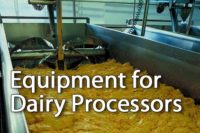
Holding Patterns
by Lynn Petrak
Tanks and tubing systems are designed for volume,
sanitation and durability needs.
At a first glance inside a
dairy plant, it may not seem like tanks and tubing systems have changed all
that much in recent times.
Vessels are still vessels and they are still used at
several points in a processing facility, from holding liquids after
receiving to mixing and blending during processing to storing pasteurized
milk and powdered products.
Tanks remain versatile, in that they are used for the
full range of dairy products, including milk, cheese, yogurt, ice cream,
whey and powdered products, and can be used for the agitation of liquids
and powders in small batches as well as for large-scale product storage in
the form of silos. In some facilities, tanks truly haven’t changed at
all, since they are the same ones that have been on the floor for 20 to 30
years.
Tubing, too, is still used for the straightforward
function of moving liquid or air from one point to another. Although piping
for processing and other purposes often has a shorter life span than tanks,
such systems have traditionally been built to last.
An up-close look at newly installed processing, mixing
and storage tanks and tubing systems in dairy settings, though, shows that
there have been definite changes in tank and tube design in recent years,
driven by regulations, safety precautions, volume adjustments and product
diversification, among other factors.
For one thing, composition isn’t the same as it
used to be. “Materials have changed and we’re using different
specialized materials. Some [processors] have gone to better grades of
stainless,” says Paul Hume, national sales manager for processing
systems and equipment at Paul Mueller Co., Springfield, Mo., which supplies
dairy customers with single-wall tanks, horizontal tanks, processing and
pasteurization tanks, silo storage tanks and smaller, portable Porta-Tanks,
among other offerings.
While many tanks are constructed with Type 304 or Type
316 stainless steel, Hume says, some dairy operators have upgraded to
materials like Type 2205 stainless and AL 6XN alloy.
Meanwhile, although most tubing and accompanying
fittings are stainless construction, the use of silicone as a material has
emerged over the past few years. CPS Limited in the United Kingdom, for
example, now offers high-strength silicone tubing designed especially for
dairy applications. In the United States, the AdvantaPure division of New
Age Industries, Southampton, Pa., supplies colored silicone tubing for
fluid and air transfer in several industries, including dairy.
Another notable trend in tank and tube design lately
has been processors’ need for systems that can accommodate their
burgeoning production capability. According to John Fearn, director of
sales for New Lisbon, Wis.-based vessel manufacturer Walker Stainless
Equipment, volume is a key driver when it comes to new tank orders from
dairies. “A lot of people, especially with consolidation, are getting
through more with less, and they are increasing capacity,” he
observes.
Likewise, supplier CPS Scherping (part of Charlotte,
N.C.-based Carlisle Group of Companies, along with Walker Stainless) is
fielding more inquiries from larger dairies about its range of tanks,
including balance, flavor mix and cheesemaking tanks. “Most often, we
hear from a plant that is doing an upgrade and they need bigger tanks and
bigger equipment, because sometimes they don’t have the right
size,” says Dan Dickhausen, engineering manager for Winsted,
Minn.-based CPS Scherping. “We make the range of tanks for small ones
up to 6,000 to 7,000 gallons.”
Hume agrees vessel sizes are getting larger as a result
of higher volumes. “We are building tanks larger for increased
capacity,” he says. In fact, he notes, one cheese company with whom
Mueller works recently invested in larger tanks to accommodate the 15
million pounds of milk that now pass through its facility every day.
Volume has an impact on tubing as well. To meet higher
flow requirements, tubes come in a greater variety of sizes and are
constructed to withstand greater throughputs.
In addition to installing larger tanks and wider and
longer tubing, many dairies that are boosting volumes are also using more
pieces of equipment, especially manufacturers that are expanding their
operations and product lines to stay competitive. “The business is
somewhat cyclical, but I’d say we are selling more equipment than
we’ve previously done,” says Hume, citing major plant
expansions by leading ice cream manufacturers that have broadened their
product lines and grown into firms with a true national and global reach.
Controlling Forces
Tanks and tubing may have straightforward functions for
respectively containing and moving through products at various
points in the system, but they also reflect today’s tightly
controlled operations.
Indeed, because volume and flow — and the loss
thereof — translate into the bottom line, precision is as important
with the use of tanks and piping as it is in other steps in the production
process. To that end, there has been an advent in high-tech, computer-based
controls that are used to run and monitor tanks and flow. “Systems
are becoming more automated and we do offer instrumentation,” Hume
says, adding that dairy processors have embraced technology that helps
improve efficiency and accuracy while keeping a lid on labor costs.
Just as operators work to ensure accuracy, they want to
do what they can to make the finished items as safe as possible. As with
other equipment used in dairy facilities, tanks and tubing are a focus of
safety efforts.
That’s why modern tanks and tubes are constructed
with stainless steel that is easily washed down and come with options for
clean-in-place (CIP) features. “Cleanability is a must for longer
shelf life,” Hume says.
Dickhausen, too, says CIP systems continue to become
more mainstream in dairy applications. “It’s been pretty
steady, and it’s gone along with process piping as well,” he
says of CPS Scherping’s requests from dairies.
Fearn, for his part, reports that sanitation is among
the top priorities of those who purchase new tanks. “Pretty much
everybody is using CIP, though there are some people who want to manually
clean their kettles,” he says.
The combination of sanitizers and frequent washdowns
can take a toll on any piece of equipment, including tanks, which is why
proper care and maintenance are key to the life span of vessels and
accompanying piping,. “We have vessels in the field that are 40 years
old and we have other people who will ruin a vessel in a year,” Fearn
explains.
New and Improved
Although changes to tank and piping designs are more on
the subtle than the dramatic side, suppliers do update their equipment for
optimum performance.
Fearn, for his part, reports that R&D work is done
on an ongoing basis at Walker Stainless. “I can’t say it is
anything ultra revolutionary, but we are perfecting existing techniques to
improve production efficiencies,” he says. “We are doing a bit
of design tweaking and more layouts of the manufacturing process for
ergonomics.”
Also indicative of today’s need-driven
manufacturing climate, in addition to choosing from a spectrum of
processing, mixing and storage tank models and tubing options, dairies can
also install custom equipment and materials that fit their particular
needs. Walker Stainless, among others, offers custom-built sanitary and
industrial models, such as aseptic storage tanks, blend tanks and
single-shell tanks.
Lynn Petrak is a freelance journalist based in the
Chicago area.
$OMN_arttitle="Holding Patterns";?>
